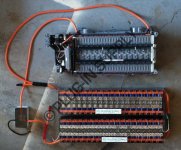SamTexas
1 MW
I'm learning about the gen I and gen II Prius. I would like to hear from Prius's owners. Thanks in advance.
I have a lot of questions, but let's begin with a few basic ones.
1) How involved is it to add the EV Mode button to a Prius sold in the USA?
2) Once the EV Mode is enabled what is the top speed (on flat) before the ICE kick in? 34mph?
3) How far can it go in EV mode when the battery is fully charged?
4) What is the LVC threshold for the ICE to kick in?
5) What are the highest and lowest voltages of the stock NiMh pack you have seen on your Prius?
I have a lot of questions, but let's begin with a few basic ones.
1) How involved is it to add the EV Mode button to a Prius sold in the USA?
2) Once the EV Mode is enabled what is the top speed (on flat) before the ICE kick in? 34mph?
3) How far can it go in EV mode when the battery is fully charged?
4) What is the LVC threshold for the ICE to kick in?
5) What are the highest and lowest voltages of the stock NiMh pack you have seen on your Prius?


